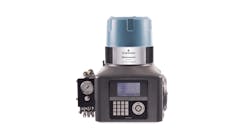Source: Emerson
While many process industry professionals increase sustainability via the familiar efficiency improvements they’ve pursued all along, reducing CO2 emissions also means going in some new and unfamiliar directions. This is another reason why net-zero initiatives are broken up into Scope 1, 2 and 3 categories, which Emerson supports with three key pillars:
- “Greening of Emerson” for improving its own sustainability performance;
- “Greening by Emerson” for supporting the sustainability efforts of its customers with process automation and related technologies; and
- “Greening with Emerson” for working with other partners, larger communities and governments to drive future sustainability innovations.
While it’s been developing the technologies needed to support power generation of blended natural gas with hydrogen for several years, Emerson also explores how to automate generation and storage of hydrogen produced from renewable energy sources. Supporters expect this green hydrogen will enable the creation of a circular economy with little or no waste or negative environmental impact.
“Using excess renewable energy capacity to make green hydrogen turns it into a storage media because that hydrogen can be used later in gas turbines or other applications,” says James Fraser, global renewable power VP at Emerson’s Power and Water Solutions business. “These efforts are further enabled by our Ovation Green renewable power portfolio of solutions, which can manage I/O for power generation, safety controls, software for managed assets and optimization technologies. All of our tools can pull more details from assets, which means they can be deployed, maintained and scheduled more efficiently. They’re also using more advanced control algorithms to predict performance, which can help with renewable energy production and storage decisions, too.”
Optimizing solar at two 25-MW sites
To develop more renewable energy applications that might eventually support green hydrogen production and storage, Emerson was recently enlisted by Lodestone Energy to automate New Zealand’s first large-scale, solar-photovoltaic (PV) project at two 25-MW sites at Kaitaia and Edgecumbe. However, efficient generation and distribution of solar PV requires precise coordination of multiple, third-party devices and controls that can give operators complete visibility, intuitive capabilities and grid stability. Consequently, the utility is implementing Emerson’s Ovation Green solar platform, using an Ovation DCS and OCR3000 controllers to provide comprehensive control that will minimize the impact of solar PV’s variability and intermittent performance (Figure 1).
"New Zealand’s goal of achieving carbon neutrality by 2050 is an ambitious endeavor that will require many renewable, power-generation sources to be safely and rapidly brought online,” says Peter Apperley, engineering GM at Lodestone. “Emerson’s expertise in automation software for power generation and sustainability will help us build a world-class facility more quickly, while also integrating more seamlessly with the national grid to drive successful, efficient operations over the lifecycle of the plant."
Lodestone’s solar PV project requires multiple interfaces to third-party systems, including inverters, high-voltage switchboards, weather stations, security systems and grid-authorized RTUs. The Ovation platform will act as a process orchestration tool to seamlessly connect these devices to provide fast and intuitive visibility for operators. Ovation automation technologies and OCR300 controllers will also make it easier for the utility’s operators to quickly respond to grid-frequency events, while Ovation’s enterprise data solutions will provide secure monitoring of solar PV operations at the control room or on mobile devices by measuring, monitoring and reporting key performance indicators. Finally, the Ovation platform and green-solar solution is suited to supporting compliance with New Zealand’s energy participation code.
“There are some easy sustainability wins and ROI in power generation and process applications by optimizing existing assets, which can move them closer to their setpoints, and reduce costs and CO2 emissions,” adds Fraser. “However, users also need a larger, overall vision for sustainability that they can work back from. Hitting net-zero targets and achieving sustainability can’t be random. Making electricity with renewables and storing energy as hydrogen improves carbon footprints, but automation, software and more data can add more small wins that will eventually become big wins.”





